Discover the steps to restore your dented garage door back to its original shape, enhancing both its functionality and aesthetic appeal.
Dealing with a dented garage door can seem like a daunting task, but fear not, it’s a fixable issue that doesn’t necessarily require professional help. This article will guide you through a simple, step-by-step process to repair that unsightly dent, restoring your garage door to its original state.
From tools you’ll need, to safety precautions and the actual repair process, every detail will be covered to ensure you get the job done right. So, whether your garage door has suffered a minor ding or a more noticeable dent, keep reading to discover a practical, cost-effective solution.
Key takeaways:
- Assess severity of dent based on size, depth, and material.
- Gather necessary tools and safety equipment for the repair.
- Follow step-by-step DIY process using heat and compressed air or body filler.
- Maintain and inspect garage door post-repair for longevity.
- Prevent future dents by clearing the area, educating others, installing bumpers, parking carefully, and performing regular maintenance.
Identifying Severity of Garage Door Dents
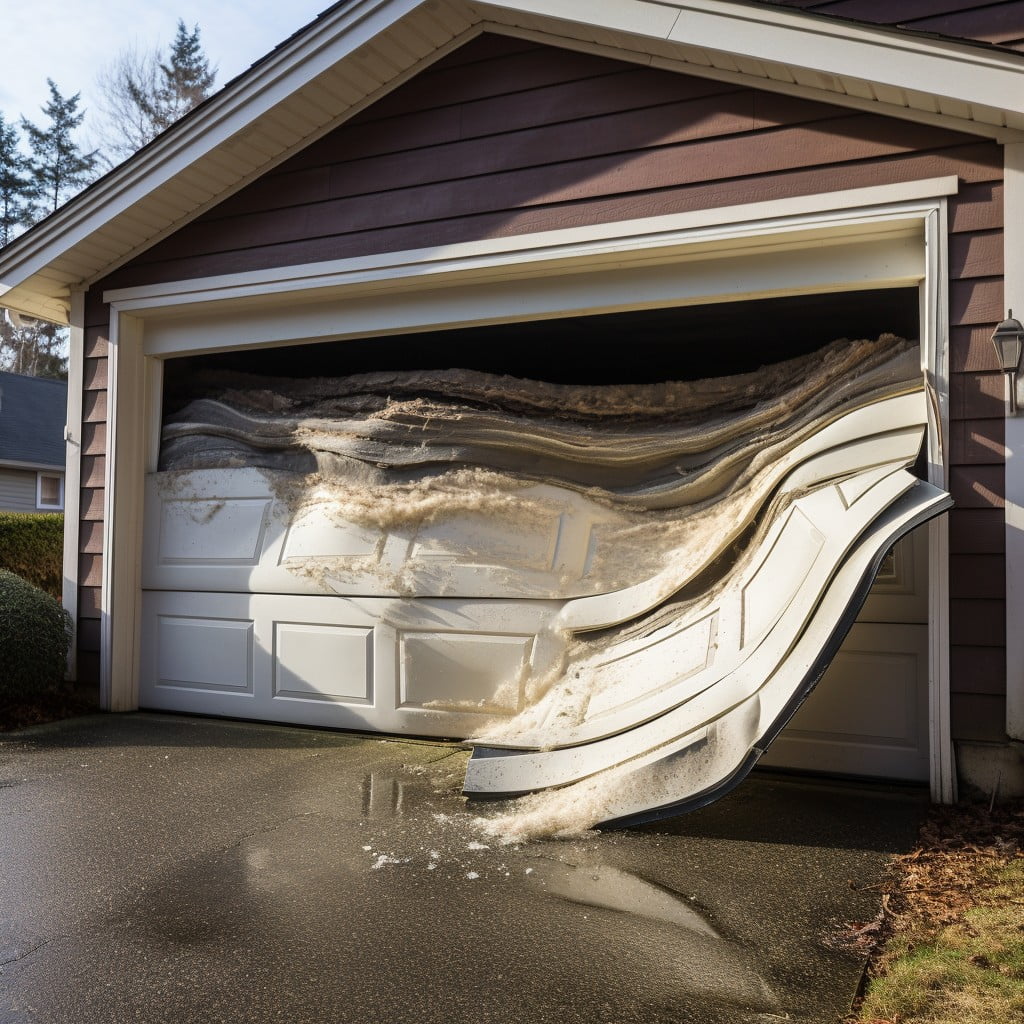
When recognizing the scale of the dent, it’s crucial to first examine its size and depth. Dents can range from minor, easily fixable indentations, to significant damages affecting the door’s operation. By lightly running your hand over the surface, you can feel the extent of the dent.
Another significant factor to consider is the door’s material. Single-layer steel doors are relatively easy to repair at home, with larger dents possibly requiring a bit more effort. However, if your door consists of composite materials or multi-layered construction, it may be complicated to repair without professional help.
Look out for cracking or split paint as well. If any severe cracking is evident around the dent, it signifies an impact strong enough to potentially affect the door’s internal mechanisms.
Understanding these specifics will help you assess whether a DIY approach is feasible, or if the dent warrants expert attention.
Tools and Materials Needed for Garage Door Dent Repair

Having the right set of tools and materials at your disposal is crucial for this task. A standard plunger is one of the most effective tools for removing smaller and medium-sized dents. Larger dents, however, may require a more specialized tool like a vacuum suction cup lifter.
Safety equipment, such as work gloves and safety glasses, are also crucial, as dents can be sharp and could potentially cause harm during the repair process.
Furthermore, to ensure a smooth and clean finish after the repair, you might also need the following: a bucket filled with clean water and dishwashing liquid, a large sponge, and fine-grit sandpaper.
For those dents that have resulted in paint damage, a primer, a matching garage door paint, and a foam roller or brush will be needed to restore the door’s original look.
In some cases, it might be useful to have a heat source like a hair dryer for hard-to-fix dents. Be careful when using a heat source, as too much heat can cause additional damage to the door’s finish.
Remember, preparing these tools and materials beforehand will save you time and ensure your repair work is efficient.
DIY Garage Door Dents Repair
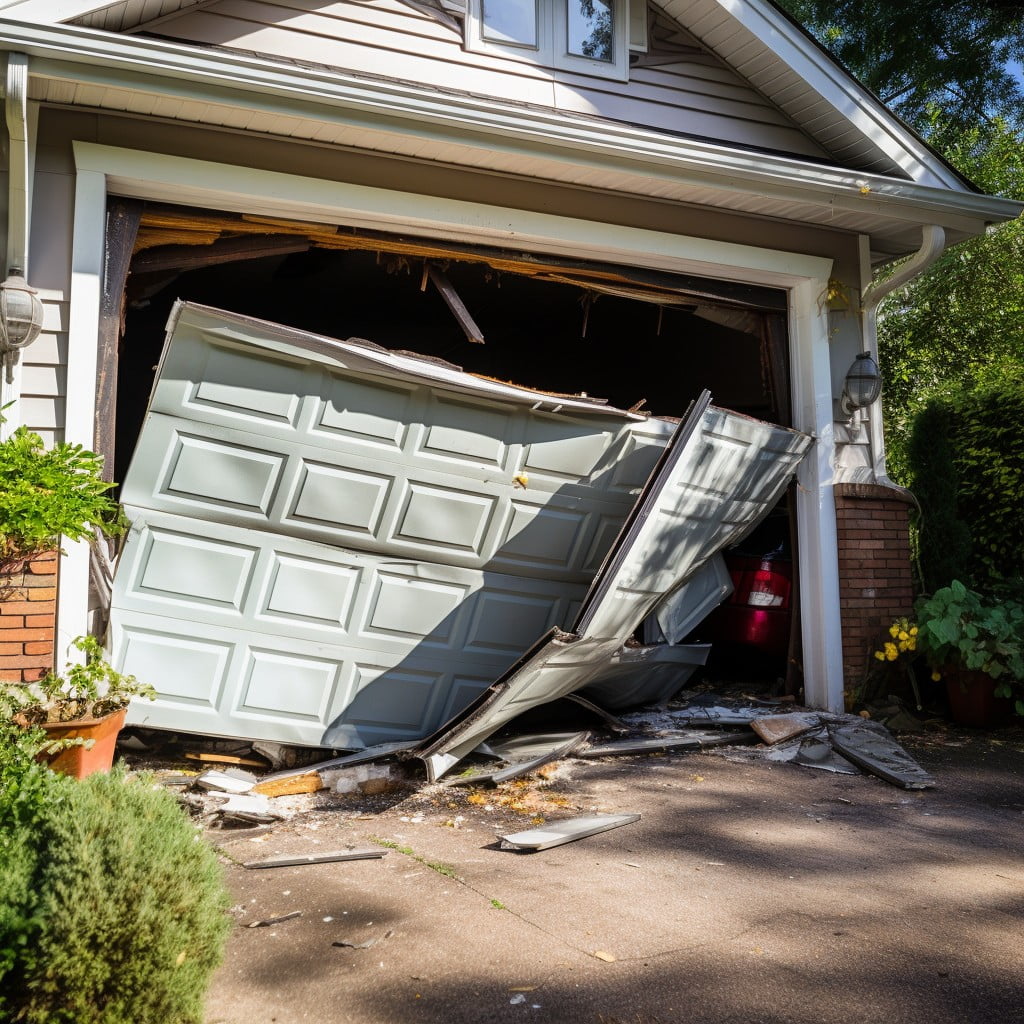
To start this repair project, first, ensure the door is clean and dry. Use a household detergent and warm water, rinse thoroughly, and allow it to dry before proceeding.
Next, take the foil of a standard aluminum foil baking sheet and cut out a section slightly larger than the dent. Lay this chunk flat against the dent and secure it in place with some form of heat-resistant tape, like duct tape.
Once the foil is set, take a lighter and heat the foil for roughly one minute. Be careful not to hold the flame in one place for too long to prevent burning. After heating, quickly remove the foil and spray the dented area with compressed air for at least 30 seconds. The extreme cold of the air and the previous heat from the flame should combine to pop the dent out automatically.
If your dent is larger or isn’t responsive to the heating and cooling method, body filler may be your next best bet. Start by sanding down the affected area and wiping clean. Following the instructions on the body filler kit, mix the resin and apply it evenly across the dent using a squeegee or similar tool.
Once it has dried, you can sand it down again for a smooth finish.
While these methods can be highly effective, it’s important to remember to tackle this project with patience. Damage can often take multiple attempts to correct.
Step-by-Step Process to Fix a Dented Garage Door
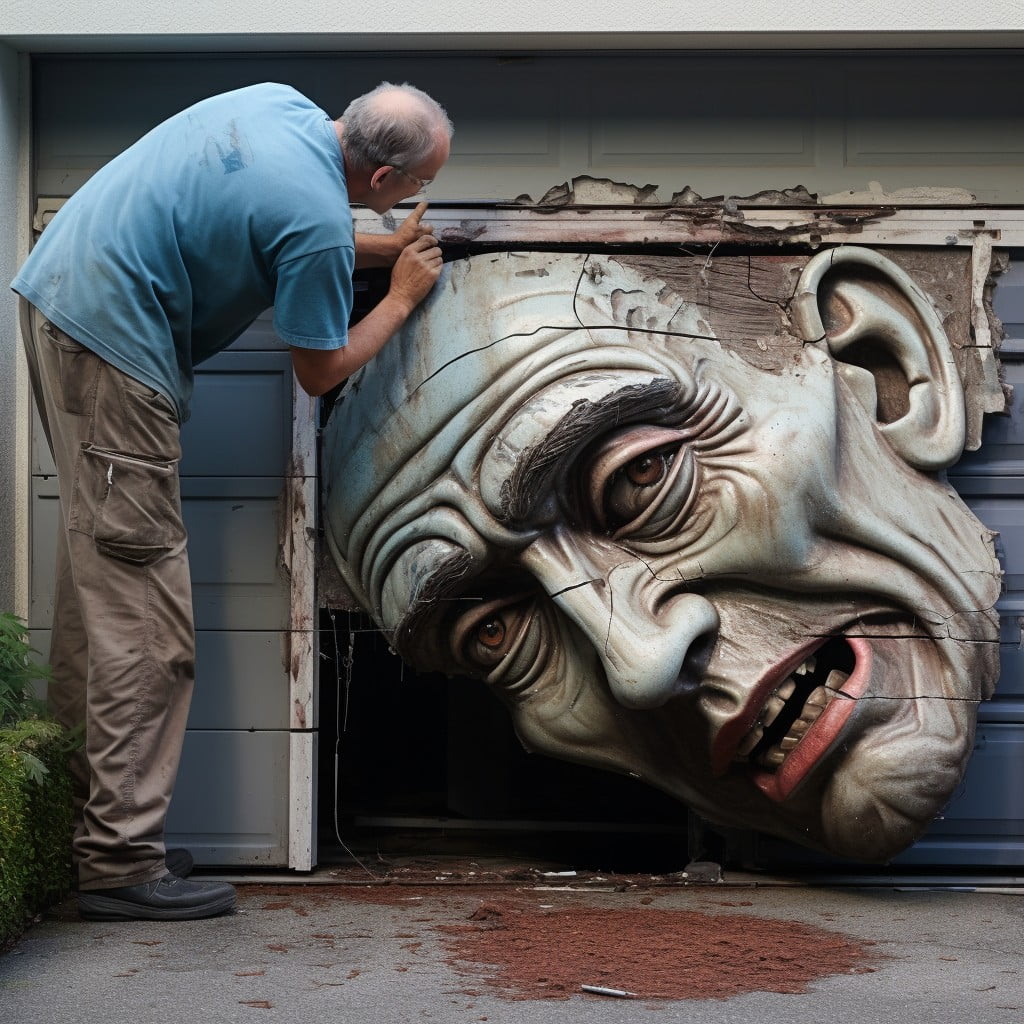
Begin by cleaning the affected area thoroughly using a standard garage soap and warm water mixture. This procedure ensures that no dirt or debris interferes with the repair process. Be sure to let it dry completely before you proceed.
Next, apply aluminum foil to the dented area. The foil serves as a heat conductor, working with heat application to ease the dent removal. Securely fix the foil, ensuring it covers the entire dent.
Heat the dented area using a lighter or a heat gun, moving it over the foil for about a minute. The heat causes expansion in the aluminum, helping to pop the dent out.
Immediately after heating, remove the foil and spray the dented area vigorously with compressed air. Ensure the can is held upside down to allow the release of cold carbon dioxide. The drastic temperature change allows the aluminum to contract, forcing the dent to fix itself back into its original position.
Please note that this process may need to be repeated a few times to effectively repair minor and medium-sized dents. Care and patience are necessary throughout this process to avoid causing further damage to your garage door.
Remember, any significant or stubborn dents might require a less DIY approach and more professional handling.
Maintaining Your Garage Door Post-Repair
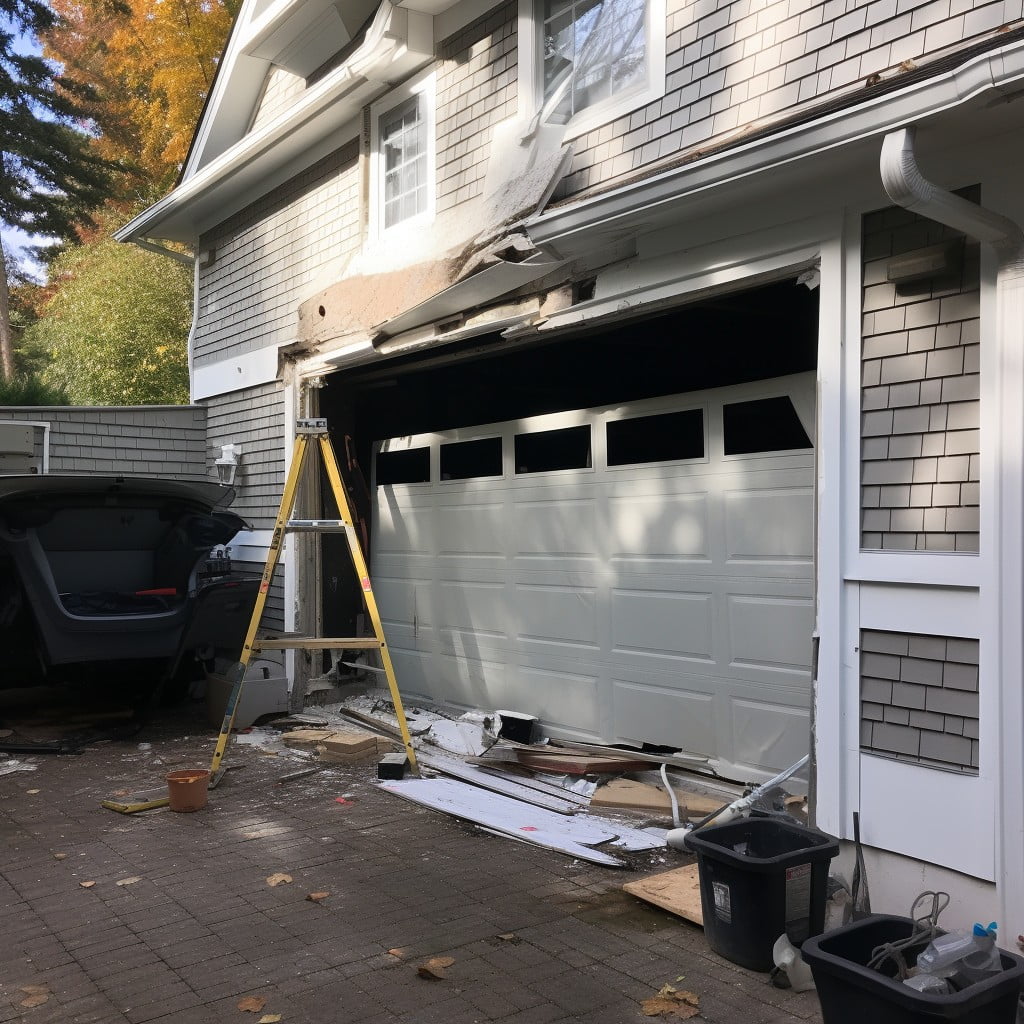
Ensuring the longevity of your recently repaired garage door relies heavily on regular maintenance. Start by thoroughly cleaning the door at least once a year. Use mild soap and water, and pay special attention to areas previously dented. This helps prevent dust and dirt buildup which could mask future damage.
Perform frequent visual inspections, focusing on the previously repaired areas. Keep an eye out for any signs of rusting, wear or renewed denting. A quick response to potential issues can save you complex repair work in the future.
Annual lubrication of moving parts is essential for smooth operation. Applying a lubricant to springs, hinges, and rollers reduces friction and wear, prolonging the lifespan of these components.
Further, ensuring the garage door opener and closing mechanisms are in perfect order is critical. Misalignment or malfunction could cause undue pressure on certain parts of the door, leading to dents.
Remember, post-repair upkeep not only prevents future dents but also helps you spot them at the onset, making fixes easier and less costly.
Preventing Future Garage Door Dents

To ward off dings and dents, consider integrating these simple strategies into your garage routines.
1. Clear the Area: Regularly declutter the garage’s interior and maintain a clear pathway for the door. Objects left close might accidentally hit the door, causing dents.
2. Teach Awareness: If the garage houses teen drivers or active children, educate them on the importance of maintaining a safe distance from the door and avoiding rough play near it.
3. Install Bumpers: Bumpers on the edges can absorb any accidental hits, protecting your door from being dented. They come in various robust materials such as rubber or foam padding.
4. Park with Precision: Make sure to park carefully every time. Rushed or imprecise parking might lead to accidental hits on the door.
5. Regular Maintenance: Periodically check the door’s condition. A well-maintained door is less likely to dent, and any minor dents can be spot repaired before they worsen.
Once you’ve implemented these tactics, sustaining a dent-free garage door will become a more manageable task.
When to Get a Professional Garage Door Repair
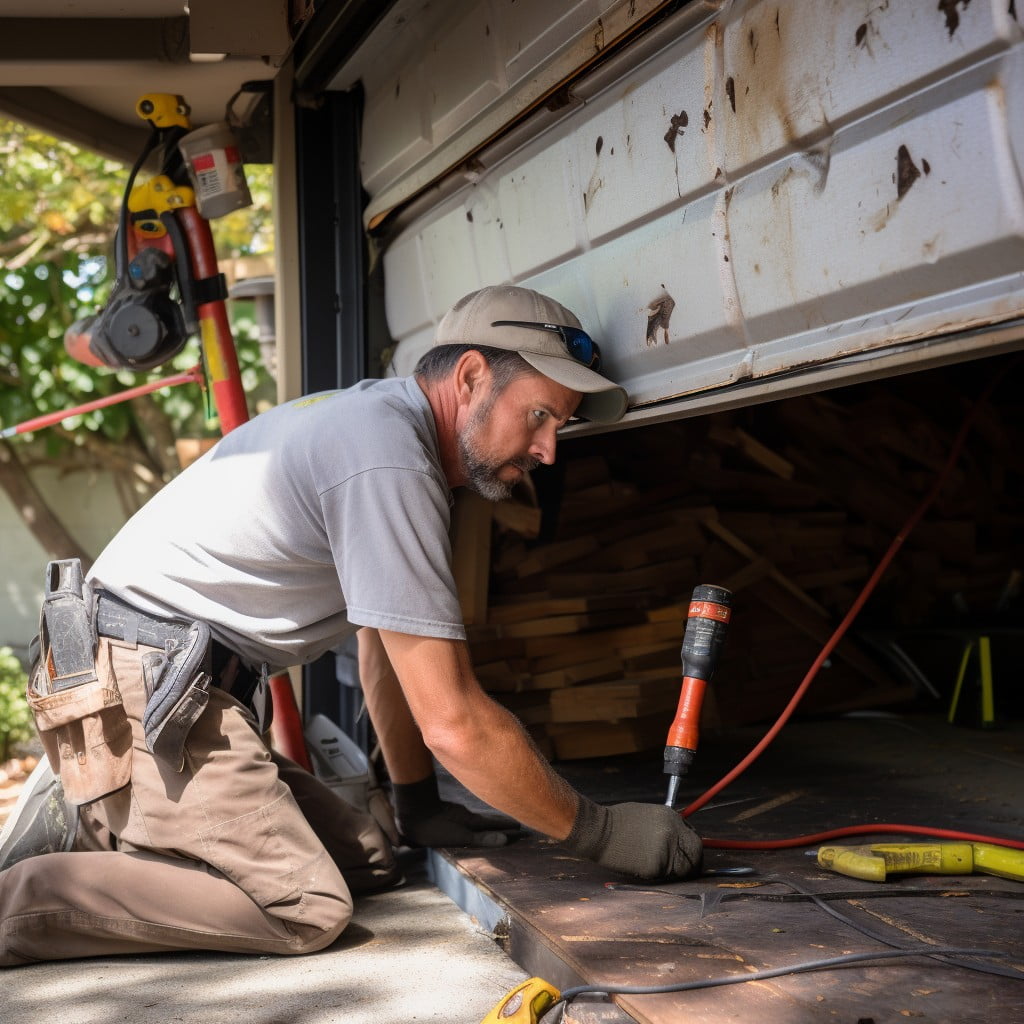
While DIY repairs can save time and money, there are circumstances when it’s best to call in the professionals. If the dent is large or involves a break in the metal, you should hire a professional to handle it. Extensive damage often requires special equipment and expertise to fix properly.
Still, it’s not just about the size of the dent. If the functionality of the door has been affected or if the door can no longer move smoothly, then professional help is needed. Operating a damaged garage door can cause more harm not just to the door but also to the garage’s structural integrity.
Safety is also a crucial factor to consider. If the dent has resulted in jagged edges or loose sections, attempting a DIY repair becomes a risky affair.
Remember, while a DIY may seem like a cheaper option initially, improper repairs could lead to more extensive and expensive damages down the line. Thus, if you aren’t confident in your repair skills, hire a professional. Given their expertise and experience, they’re equipped to handle any type of repair efficiently and safely, ensuring your garage door works flawlessly.
Finally, consider the material of your garage door. Some materials, like wood or high-end composite, can be difficult for amateurs to repair without causing unintended damage. For such delicate materials, let the professionals do their job.
FAQ
Can dents in garage doors be repaired?
Yes, smaller dents in garage doors can be repaired, but larger ones will likely require door replacement.
Can a bent garage door be fixed?
Yes, a bent garage door can be fixed, often through methods such as hammering out the dent, using suction cups, or applying heat to return the door to its original shape, depending on the severity of the damage.
Can you fix dents in a metal door?
Yes, you can fix dents in a metal door by using specialty filler and sandpaper, followed by a coat of paint, after thoroughly cleaning the door.
How to utilize home remedies for fixing dented garage doors?
To utilize home remedies for fixing dented garage doors, apply heat to the dented area, cool it rapidly, and then use a plunger or similar suction device to pop out the dent.
What professional services are available for repairing dented garage doors?
Professional services available for repairing dented garage doors include professional garage door companies, independent contractors, and handymen who offer dent repair, door panel replacement, or full garage door replacement services.
What are the common causes behind garage door dents and how to prevent them?
Common causes of garage door dents include impact from vehicles, sports equipment, weather damage, and regular wear and tear, while prevention measures include careful driving, storing equipment properly, installing weather barriers, and regular maintenance and inspection.